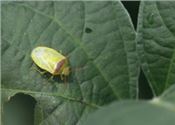|
Redbanded Stinkbugs Threaten State's Maturing Soybean Crop

Redbanded stinkbugs, such as this pest seen Aug. 17, 2017, on a soybean plant at the Delta Research and
Extension Center in Stoneville, Mississippi, are very damaging, invasive pests showing up in large
numbers this year in fields across the Southeast.
Photo by MSU Delta Research and Extension Center/Don Cook
STARKVILLE, MISS.
Farmers in Mississippi and the Southeast are urged to scout their fields closely for the redbanded stinkbug, a very damaging pest of soybeans that is being found in increasing numbers across the region.
Mississippi State University Extension Service specialists and researchers joined with their counterparts and crop consultants from Arkansas and Louisiana Thursday for an emergency forum on this dangerous insect.
Angus Catchot, Extension entomologist, said the redbanded stinkbug is more damaging than the traditional stinkbugs typically found in Mississippi crops. Specialists urge producers to begin control measures when lower numbers of these pests are found in fields.
“Our threshold that triggers pesticide treatments is four redbanded stinkbugs per 25 sweeps instead of nine per 25 sweeps, which is our threshold for native stinkbugs,” Catchot said. “We manage redbanded stinkbugs at that same threshold through the R7, or beginning maturity, growth stage. This is a big difference from what we have been used to doing in the past.”
The biggest threat from the redbanded stinkbug comes from its ability to damage soybean plants much later in the reproductive stages than producers are used to seeing with traditional stinkbug species.
Don Cook, Mississippi Agricultural and Forestry Experiment Station research entomologist, said redbanded stinkbugs are invasive, non-native pests first seen in the state in 2009. Louisiana producers have been dealing with this invasive pest since 2000.
“They don’t handle cold weather very well, and the winter of 2009 was cold and killed them off,” said Cook, who operates from the Delta Research and Extension Center in Stoneville. “We didn’t really see them in the state again until 2016, when central Mississippi had pretty high numbers of this pest.”
Last winter was mild, giving the pests an opportunity to overwinter in the state.
“They got on weeds in April, and, once they had a foothold, they just moved on up the state,” Cook said. “If we have a cold winter, we may not see this pest again in 2018.”
Catchot said redbanded stinkbugs are most dangerous to soybeans, but, on occasion, they get into cotton and must be treated. This year, they are being found in high numbers in peanuts in south Mississippi.
“Peanuts are likely not affected by them, but they serve as a source to grow the population that may later move into soybeans,” Catchot said.
August’s wet weather has contributed to the problem with this pest.
“Due to the recent heavy rains, many producers have been unable to effectively treat soybean fields for redbanded stinkbugs, allowing their numbers to increase,” Catchot said. “Stinkbugs feed on water-soaked pods, which opens avenues for disease entry. That may further affect the quality of the soybean crop.”
Although it is a devastating pest, good scouting and timely applications of pesticides can control it.
“Base decisions on sound scouting, and stay tuned to Extension Service reports for the latest information available on this pest,” Catchot said. ∆
|
|